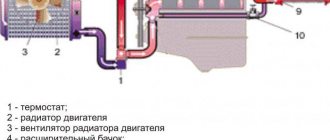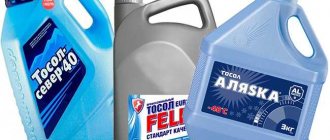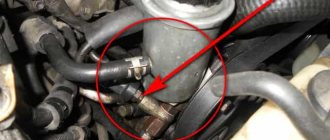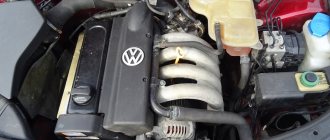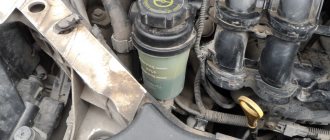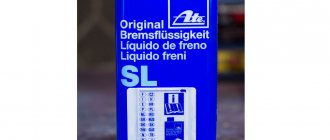Modern cars are highly reliable and have a long guaranteed mileage. Many components can operate without maintenance for a long time, but most systems require regular diagnostics.
One of the most responsible options for servicing a car is replacing antifreeze in the Kia Rio 3. This procedure can be performed either independently or at a certified service center. However, in the latter case, replacing the coolant will cost a pretty penny.
The need for a drain plug
Every modern car has a cooling system. Its functional responsibilities include storing, supplying, and circulating fluids to reduce engine temperature. Thanks to this system, the radiator maintains the optimal temperature longer, thereby reducing the risk of overheating
. If you drain the coolant in a timely manner, you can extend the service life of the car and maintain its original quality.
How to drain all antifreeze using the example of Daewoo Lanos
- The car is placed on a flat surface and the engine is turned off. The engine must be completely cold before draining begins.
- Place an empty container under the lower left corner of the radiator (a small basin with a capacity of at least 6 liters will do). After this, the drain plug is unscrewed.
An empty container is placed underneath it.
- The expansion tank cap is unscrewed.
This cover must be unscrewed
- To make draining faster, remove the hose from the fitting on the throttle assembly. This is done using pliers and a screwdriver.
The clamp is loosened with a screwdriver, the hose is removed with pliers
- Since the Daewoo Lanos engine does not have a hole for draining antifreeze, the right rear wheel of the car is jacked up and raised as high as possible. The car sits in this position for 20 minutes. After this, the car is lowered and the right front wheel is jacked up. In this position, the car sits for another 20 minutes, and a little more antifreeze drains from it.
- If the antifreeze pouring out is very dirty, the cooling system is flushed with water. The plug on the radiator is screwed in, after which clean water is poured into the expansion tank until it begins to flow out through the hose on the throttle assembly, which was removed earlier. After this, the hose is put in place, the expansion tank is closed and the machine engine is started. The engine runs for 5–7 minutes, after which it is turned off and the water is drained. This cycle should be repeated until clean water flows through the drain hole in the radiator. If this happens, it means there is no old antifreeze in the car.
- After this, the cap on the radiator is tightened and new antifreeze is poured.
As you can see, the absence of a drain hole on the engine block can cause a serious headache for the driver, and he will have to resort to a variety of tricks to drain the coolant. What guided the designers of the Daewoo Lanos engine when depriving the car owner of the opportunity to properly drain antifreeze is a big mystery.
- Author: Alexey Stepanov
Copywriter with five years of experience. Rate this article:
- 5
- 4
- 3
- 2
- 1
(17 votes, average: 3.6 out of 5)
Share with your friends!
Preventative flushing of the circuit
If the coolant in the car has not been changed for a long time for any reason, it is recommended to flush the system when replacing it. For this, ordinary distilled water can be used, which is poured after removing the old antifreeze from the circuit. If desired, you can add special flushing agents to it, which are available for sale in many car dealerships. Flushing the system in this way should be done with the engine running. After the engine has run for several minutes, distilled water is drained from the radiator and cylinder block. After this, you can pour in fresh coolant.
What to do after replacing the coolant
In the next few days after adding fresh antifreeze, you should periodically check the coolant level in the tank and inspect the engine compartment for the presence or absence of leaks. During this period, the amount of liquid in the expansion tank may decrease slightly; this is considered normal. The fact is that after replacing the coolant, the channels inside the cooling circuit are gradually filled. This requires a certain amount of antifreeze. When all working channels in the system are finally filled with liquid, its level in the expansion tank stabilizes and remains at the same level. As a rule, this takes 1–3 days depending on the operating mode of the vehicle.
Antifreeze
In order for the car engine to work properly both in winter and in summer, it is necessary that the cooling system is always in good condition.
To do this, you need to change the antifreeze after a certain point in time, often after two years or forty to sixty thousand kilometers. It is during this period that it loses its characteristics. An approximate signal that it is time to change the antifreeze may be a change in its color. This indicates that the additives contained in the composition have lost their properties.
Coolant functions
- protection against engine overheating and boiling;
protection against freezing in winter, when the air temperature outside drops many levels below zero;
corrosion protection.
Why doesn't the antifreeze drain completely?
The fact is that draining coolant from a car can be divided into 2 stages: draining antifreeze directly from the radiator and draining it from the engine cooling system.
Engine cooling system of Lada Priora: 1 — heater radiator; 2 — coolant drain hose from the heater radiator; 3 — coolant supply hose to the heater radiator; 4 — coolant pump hose; 5 — expansion tank hose; 6 — steam removal hose of the heater radiator; 7 — expansion tank cap; 8 — expansion tank; 9 — thermostat; 10 — coolant drain hose from the engine radiator; 11 — hose for supplying fluid to the throttle assembly; 12 — steam exhaust hose of the engine radiator; 13 — hose for supplying fluid to the engine radiator; 14 — engine radiator; 15 — radiator drain plug; 16 — electric engine radiator fan; 17 — coolant pump; 18 — supply pipe of the coolant pump; 19 — coolant drain hose from the throttle body
As a rule, there are no problems with the radiator. The plug is located at the bottom, and all you need to do is unscrew it and substitute an empty container. But at the same time, antifreeze will still remain in the engine. It can be extremely difficult to pour it out of there because:
- The engine cooling system is a complex structure, in which there are a lot of curved cavities, horizontal recesses, etc. Old antifreeze remains in all these areas. It simply cannot pour out of there “under its own power” (i.e., under the influence of gravity).
- Automakers make mistakes too. Such design errors include the absence of a hole for draining antifreeze from the engine.
This is interesting: Xenon lamps for cars
Why did it happen so?
Perhaps the automatic requests do not belong to you, but to another user accessing the network from the same IP address as you. You need to enter the characters into the form once, after which we will remember you and be able to distinguish you from other users exiting from this IP. In this case, the page with the captcha will not bother you for quite a long time.
You may have add-ons installed in your browser that can make automatic search requests. In this case, we recommend that you disable them.
It is also possible that your computer is infected with a virus program that is using it to collect information. Maybe you should check your system for viruses.
If you have any problems or would like our support team, please use the feedback form.
Being the owner of even the most expensive and comfortable car is very difficult. After all, despite the numerous advantages that motorists enjoy, maintaining an “iron horse” can be quite expensive. This is especially true for those drivers who often operate their cars in poor conditions, for example, on uneven, potty roads or using low-quality fuel.
Numerous breakdowns and high fuel prices are just the tip of the iceberg of problems for motorists. Sometimes in life there are situations when you have to save even on yourself, not to mention the car. What to do if a car is a vital necessity, something is broken in it, and there is no money for expensive auto repair shop services? The only way out in such a situation is knowledge and, of course, skillful hands. So why not fix your car yourself by putting them into practice? After all, it’s easy if you study the well-written instructions and strictly follow them.
And today, using the example of the Russian car Lada Priora, we will look in detail at replacing the coolant. This is one of the most pressing topics for every driver, because coolant is very important in the operation of a car - thanks to its presence, the temperature of the car’s engine is always kept at the same level when driving, which avoids overheating and failure. Therefore, it is especially important to monitor the condition of the engine cooling fluid every time you drive.
Benefits of using multifreeze
If you plan to replace the coolant, you should pay attention to the products of SINTEC Lubricants. The company produces high-quality multifreezes that have high performance characteristics and can be mixed with other types of coolant. The composition includes special protective additives that prevent corrosion of aluminum, copper and brass cooling radiators, thereby increasing their trouble-free operation. An important feature of MultiFreeze coolant is that the material is designed for the entire period of operation of the vehicle. Multifreeze does not need to be regularly changed every 2–5 years. The coolant retains its original properties (thermal conductivity, anti-corrosion characteristics, protection against cavitation) for a long time, which significantly reduces the cost of vehicle maintenance.
Coolant selection
Before you begin replacing consumables, you need to determine the appropriate composition. Antifreeze brands G11, G12, G12+, G13 and others are available for sale, which differ significantly in properties. The compositions interact with each other differently, so during the next maintenance it is recommended to choose a fluid of the same class that was used previously or is indicated in the service book for the car. Universal multi-freezes are also produced, which are fully compatible with coolant of most other brands. The production of such materials is carried out by the company SINTEC Lubricants. MultiFreeze series fluids are suitable for almost all car models, regardless of engine type and design features of the cooling system.
How much antifreeze to pour into the system
When replacing coolant, follow the vehicle manufacturer's recommendations. Exact information about the volume of antifreeze in the circuit should be indicated in the service book for the car. Only minor deviations from the recommended amount of coolant are allowed. It is important that its level in the expansion tank is strictly between the Min and Max marks, which are marked on its body. Exceeding the maximum level risks the fact that when heated, the expanding liquid will create excess pressure in the circuit, which can lead to depressurization, rupture of hoses, breakdown of the radiator and other consequences. Antifreeze can also be squeezed out through the tank or radiator cap, which is extremely undesirable. Lack of coolant in the circuit is no less dangerous. If the amount of antifreeze is insufficient, the performance of the cooling system is reduced, which can lead to overheating of the engine.
Filling with coolant
Before you start pouring coolant into the system, make sure that all drain holes are tightly closed. This will avoid unnecessary costs. The procedure for filling the cooling system on the “classic” and on the VAZ family, starting with model 2108, is slightly different. The latter use a sealed system in which the liquid is under a certain pressure. It is regulated using two valves that are located in the plug. Hence the conclusion - in order to drain the coolant from the VAZ-2110, you will need to open the plug. There is one more small feature - there is no provision for pumping the system as such. It is enough just to fill in antifreeze, warm up the engine to operating temperature and let it run for a while. But in the “classics” you need to act somewhat differently. In general, difficulties with refilling the coolant system should not arise. The main thing is to know exactly how much liquid is in the system.

